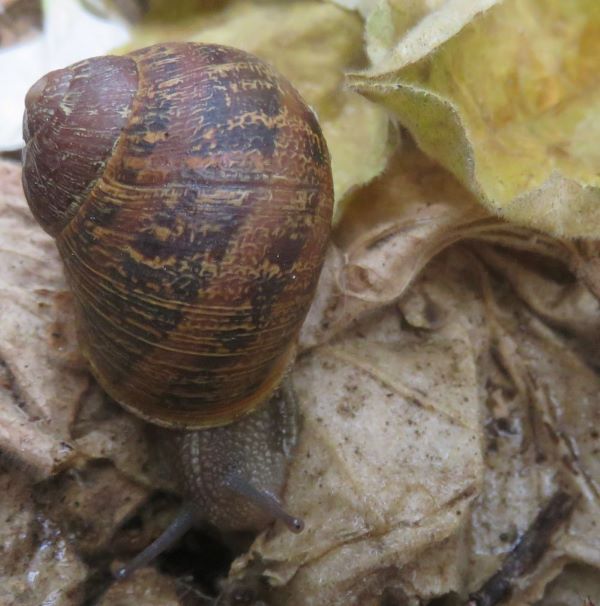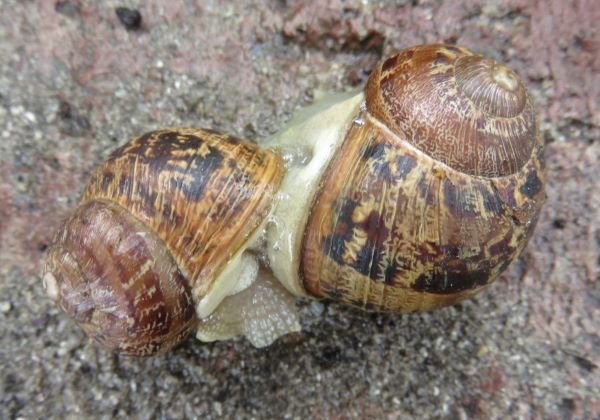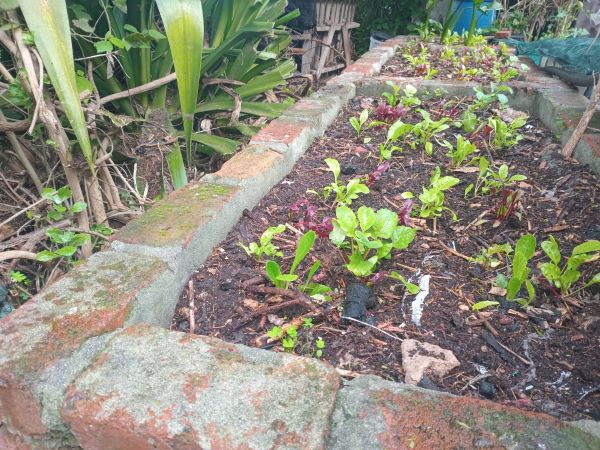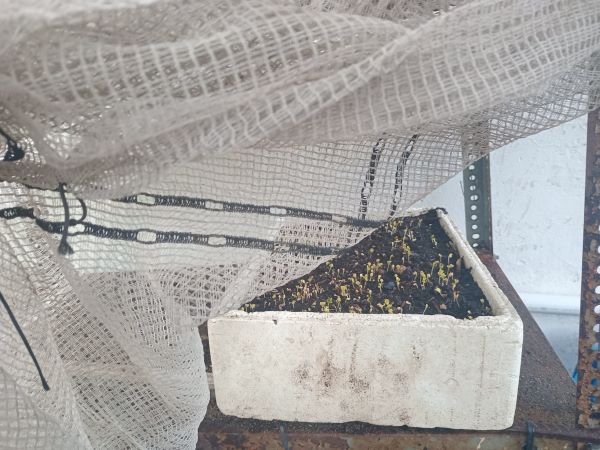| Back to Back Issues Page |
 |
|
Restore Nature, Issue #25 June 20, 2025 |
HelloRESTORE NATURE NEWSLETTERJune 2025Eeeek !!! SNAILS !!!
Hello dear Reader For once some northern and southern hemisphere gardeners have the same concerns in the very same month ! The serious onset of our winter rainy season coincides with the explosion of summer growth for most subscribers. This means snail season is on for us both ! I see the snail pages on the website climb in popularity. I'm delighted that a lot of interest is shown, not in how to kill, but how to tolerate, how to manage, how to appreciate. Snail sex clearly becomes a more interesting topic, as does the benefit snails bring. I can see that readers are trying to solve the problem of being able to enjoy the fruits of their hard work and yet not damaging the ecosystem. I feel the same and really identify with this quest. People are pretty fascinated by snail behaviour as they go down the rabbit hole looking for solutions. Here below is a link to some of my own research on the sensory life of snails and their mating behaviour, and on why they move so slowly. All of this is useful information in their management. snail-mating-behavior.html snails-move.html 
Snails and biodiversity ?W...H...A...T...? My message on this website is that we CAN preserve biodiversity while growing food. Therefore I really related to a film linked below about snails. It was made by a German speaking wildlife gardener. Not many people speak that language outside the German speaking sphere of the world, so I will pick out some exciting and informative highlights which probably apply across the planet. Markus Burkhard Schnecken vielfalt The vlogger and nature lover. Markus Burkhard has a beautiful 'Naturgarten' in Austria. The 'Nauturgarten' is broadly the German version of the English 'wildlife garden'. He took the trouble to travel to see a snail expert Katherina Mason in this youtube video to find out more about these often much hated garden 'pests'. Do snails even benefit the garden ?Markus' question as to whether snails have any use to us as gardeners was answered with a definite yes by Katherina.Most snails eat dead not living plants or are detritivores that build compost and soil. Some snails and slugs are carnivores and eat other snails. Spreading snail poison will take out the beneficial snails too. In South Africa and in this region we've also a handful of carnivorous snail eating snails, see the link below. Unfortunately our biodiversity has been so reduced in the suburbs that I've never seen them. I thought I had, but it was another invasive snail species. At the very least, all snails serve as food for other creatures and can contribute to biodiversity in the garden. According to the Austrian snail expert Katherina, they are also bioindicators of the health of your garden. The greater the diversity of snails the better your garden's biodiversity. A preponderance of invasive vegetable eating snails indicates less biodiversity in the rest of your domestic ecosystem. Katherina explained that becaause of this snails are used by scientists to ascertain the health of nature reserves, expecially aquatic snails as they are very sensitive to water quality. Below is a link to my article on the benefits snails can bring Different species have different directions for their spirals, clockwise or anti clockwise. The zoologist Katherina Mason used the spiral direction and other characteristics to identify ten different species in her quite ordinary suburban garden in Austria. Different snails have different habitat preferences, but they must all shelter against drying out by day. They like to shelter in compostheaps, wood piles, in cracks in stone walls and under shady foliage, says Katherina. I've observed them do all this too. I've also seen a lot of them on our lime coated walls when its raining. They have eaten all the paint off the walls. I've put an article on my research about snail growth patterns below. It helps explain why they are such good paint strippers. Our findings in our war on snailsLike many gardeners I've spent years in open combat with snails in my garden.I will give a background from my snail experience here in Cape Town, and something about what I do about them. A variety of indigenous snails is not the problem here. In the garden there is little mollusc diversity but plenty of abundance of one invader. It is the exotic snail Helix aspersa that gobbles up my veggies if given a chance. They are so prolific. One thing we don't do is use poisons or snail bait on them. This is an organic garden we keep for one, but you'll see the other reasons why as the story unfolds. We also don't stamp on them, which considering our other approaches may actually be a more humane type of mercy killing. In snail season my partner goes into top gear with midnight torch explorations, gathering trips during rain and careful inspections where he sees damage. He has a theory that they are sluggish (surprise) and don't move far from their food. He will search under the closest objects where they may find a place to hide, under pots, in cracks and snuggled in leaves and sticks. Then he puts them in a bucket and leaves them to die which is inhumane, or feeds them to his fish. We've tried beer traps and they caught a few snails while the rest laughed and multiplied. I used to catch them and freeze them, even tried eating them, and started a snail farm to use them like earthworms, but they didn't stick around like earthworms. I always had a laissez faire nature, and I'm more easily given to admitting defeat. The shere quantity of these one footed denizens of the garden fills me with despair and I've slid into doing nothing. My better half shouts with scarcely suppressed excitement “its raining, come get your bucket, the snails are out” and I respond by outdoing any snail in my sluggishness. I don't believe it makes any difference. Below is a picture of four winter greens growing in a raised bed. I cannot be sure of their future, but I do hold out some hope now. 
The strategies I use with snailsI hope after considering the pointlessness of fighting the snail invasion in our rainy season, the harm that snail poisons can do and the usefullness of snails in the biodiversity garden when they can be kept away from tiny seedlings, that I can be forgiven for letting them be. It also saves me a lot of time and I'm a busy busy lady.I practice avoidance and circumvention. This takes the form of overplanting so that there is enough for everyone, and eating vegetables they don't like. This winter my cos lettuce, which did very well two years ago, did not survive beyond germination. It was a total slaughter. I managed to save two tiny seedlings but don't hold out much hope. Notably they were eaten when only a couple of centimeters tall. As adult plants the cos merely suffered a few holes in its older leaves. This seems to prove that snails like very soft plants, either seedlings or leaves which are dying. Chard, beet and some relatives of Malabar spinach and the Ipomeas don't seem to suffer much. Native greens are also not prone to being denuded. I have noticed that planting in containers or high up gives a measure of protection. This may be due to the sluggish snail nature again. Certainly inground beds are a no go zone for many vegetables. I don't bother to plant lettuce, peas and any sweet leaved things in the ground. As snails also go for the young and tender, some protection can help in the early stages of growth. I germinate my seedlings in an old metal shelf. The height and perhaps the conductivity of the metal seems to deter them. But once they get into the seed trays they are a menace. I've even found one laying eggs in my sixpacks. Its said they don't like metals, certainly copper. I've a lot of waste electrical wire from my dad's old workshop and I intend stripping it and winding the copper along the top edges of my grow beds. It should fit with my woven beds especially. It will be an experiment. Below is a close up of germinating kale seedlings in my metal shelf with netting against birds and other brassica loving gourmets.

Please tell us your snail stories !Everyone who gardens has experienced snails or slugs eating their plants. I invite you to share your experience with molluscs in your garden. I am very curious about how others cope with the phenomenon, and your words, or tips and hacks can help other people all around the planet to eat home grown food and support biodiversity at the same time, with less conflict between the two.Below are some more thoughts on why I practice lazy or do nothing managment with our snail 'problem'. Creating domestic spaceGlancing back at the last newsletter about creating capacity, I can say it really works for me. My attempts at creating capacity in the garden are moving ahead. I've one day a week to work on it, and that is 52 days a year, in which one can accomplish a lot. The work done thus far with reorganizing the composting process and thorny brush storage is really paying off. I'm also working on creating capacity inside the house, tidying up and decluttering. I've done quite a bit of research as its a huge problem for me. Nothing worked until I stumbled on the diamond decluttering strategy for ageing hoarders like myself. I may share it in the next newsletter as even gardeners, who have the most longevity boosting hobby on the planet, need tranquilty and de-stressed environments. Drop me a yes if you can. If I get no response I'll stick to gardening topics and biodiversity next month.Topic suggestions welcomeYou may write to me anytime at the website greenidiom by filling out a comment. You can also use my webmail (website mail) address greenidi@greenidiom.com. Have you missed anything ?Please go to back issues right below if you want to catch up with what I've sent thus far as preamble for the course, as well as previous newsletters. |
| Back to Back Issues Page |